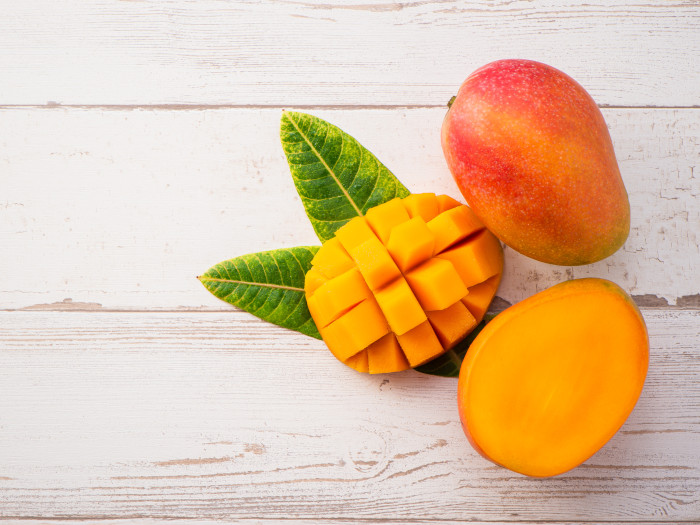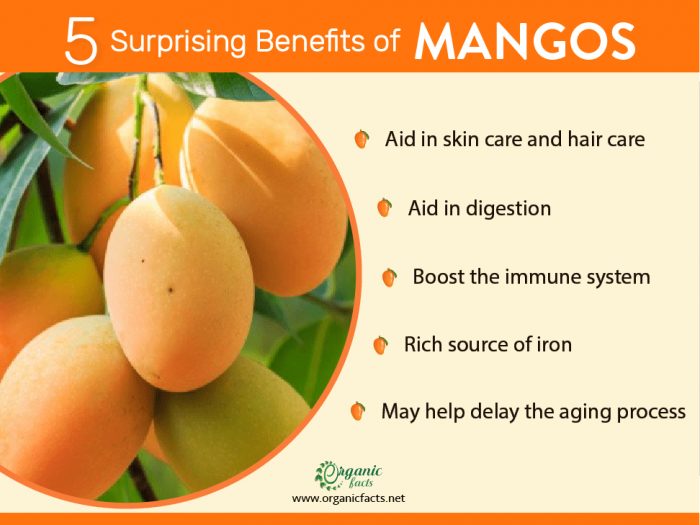When you savor delicious and succulent mangoes every summer, you may not realize the immense health benefits that come with every bite. Mango is native to Southeast Asia. It is the national fruit of India, Pakistan, and the national tree of Bangladesh. In India, it is also used in many Hindu sacred rituals. The leaves are used for festivals and wedding decorations. ‘Chutney’ made from mangoes has become universally popular. As the popularity of mangoes has spread, many food manufacturers have introduced jellies, jams, squash, pickles, marinades, and spices that include pure mango flavor.
What is Mango?
Known as the king of fruits, mangoes are tropical fruits that belong to the same family as that of pistachios, gandaria, mombin, and cashews. Mangoes are also known by other names like mangot, manga, and mangou, depending upon the region you are in. Ripe mangoes have a sweet, floral taste. Many varieties also have a citrusy flavor. Beyond the luscious taste of mangoes, there is an abundance of vitamins, minerals, and antioxidants that ensure optimum health.
Research published in the Journal Comprehensive Reviews in Food Science and Food Safety has demonstrated that certain vitamins, minerals, antioxidants, and dietary fibers in mango have a positive effect on eliminating degenerative diseases. One specific example is its potassium content, which may help replete losses from the body during strenuous activities. [1]

Neatly diced mangoes Photo Credit: Shutterstock
You can take a look at the popular types of mangoes here.
Mangoes Nutrition Facts
Mangoes are probably very low in saturated fat, cholesterol, and sodium. They may be an excellent source of dietary fiber and vitamin B6, as well as a good source of vitamin A and vitamin C. As per the USDA National Nutrient Database, it is rich in minerals like potassium, magnesium, and copper. It may even be one of the best sources of quercetin, beta-carotene, and astragalin. [2]
One cup of sliced raw mango (165g) contains about 99 calories. While you can enjoy cubed mango, you can also add it to your smoothies, salads, and juices. [3]
Health Benefits of Mangoes
Let’s look at some of the other health benefits of mangoes in detail:
Can Help Maintain Overall Health
According to a 2017 study published in the journal Nutrients, [4] mangoes have an impressive vitamin and mineral content. They are rich in potassium (4 percent in 156 mg) and magnesium (2 percent in 9 mg). Mangoes can also be vitamin powerhouses, rich in B-vitamins, vitamin A, vitamin C, vitamin E, and vitamin K. These components can help you avoid a host of diseases that can come from deficiencies of these micronutrients. Powerful antioxidants in mangoes may even help neutralize free radicals throughout the body and help prevent heart diseases, premature aging, and many other degenerative diseases.
May Promote Weight Gain
Eating and including mangoes into other dishes can be one of the easiest ways to promote weight gain. Less than one cup of mango (150 grams) may have around 86 calories, which can be absorbed easily by the body. Mangoes contain starch, which transforms into sugar and can aid in gaining weight. Mango milkshake could accelerate the process of gaining weight since it contains sugar, as well as fat and protein from milk. It is also notoriously delicious!
| Serving Size : | |
|---|---|
| Nutrient | Value |
| Water [g] | 83.46 |
| Energy | 60 |
| Energy [kJ] | 250 |
| Protein [g] | 0.82 |
| Total lipid (fat) [g] | 0.38 |
| Ash [g] | 0.36 |
| Carbohydrate, by difference [g] | 14.98 |
| Fiber, total dietary [g] | 1.6 |
| Sugars, total including NLEA [g] | 13.66 |
| Sucrose [g] | 6.97 |
| Glucose (dextrose) [g] | 2.01 |
| Fructose [g] | 4.68 |
| Calcium, Ca [mg] | 11 |
| Iron, Fe [mg] | 0.16 |
| Magnesium, Mg [mg] | 10 |
| Phosphorus, P [mg] | 14 |
| Potassium, K [mg] | 168 |
| Sodium, Na [mg] | 1 |
| Zinc, Zn [mg] | 0.09 |
| Copper, Cu [mg] | 0.11 |
| Manganese, Mn [mg] | 0.06 |
| Selenium, Se [µg] | 0.6 |
| Vitamin C, total ascorbic acid [mg] | 36.4 |
| Thiamin [mg] | 0.03 |
| Riboflavin [mg] | 0.04 |
| Niacin [mg] | 0.67 |
| Pantothenic acid [mg] | 0.2 |
| Vitamin B-6 [mg] | 0.12 |
| Folate, total [µg] | 43 |
| Folate, food [µg] | 43 |
| Folate, DFE [µg] | 43 |
| Choline, total [mg] | 7.6 |
| Vitamin A, RAE [µg] | 54 |
| Carotene, beta [µg] | 640 |
| Carotene, alpha [µg] | 9 |
| Cryptoxanthin, beta [µg] | 10 |
| Vitamin A, IU [IU] | 1082 |
| Lycopene [µg] | 3 |
| Lutein + zeaxanthin [µg] | 23 |
| Vitamin E (alpha-tocopherol) [mg] | 0.9 |
| Tocopherol, beta [mg] | 0.01 |
| Tocopherol, gamma [mg] | 0.01 |
| Tocotrienol, alpha [mg] | 0.03 |
| Tocotrienol, beta [mg] | 0.01 |
| Vitamin K (phylloquinone) [µg] | 4.2 |
| Fatty acids, total saturated [g] | 0.09 |
| 12:0 [g] | 0 |
| 14:0 [g] | 0.01 |
| 16:0 [g] | 0.07 |
| 18:0 [g] | 0 |
| Fatty acids, total monounsaturated [g] | 0.14 |
| 16:1 [g] | 0.07 |
| 18:1 [g] | 0.08 |
| Fatty acids, total polyunsaturated [g] | 0.07 |
| 18:2 [g] | 0.02 |
| 18:3 [g] | 0.05 |
| Tryptophan [g] | 0.01 |
| Threonine [g] | 0.03 |
| Isoleucine [g] | 0.03 |
| Leucine [g] | 0.05 |
| Lysine [g] | 0.07 |
| Methionine [g] | 0.01 |
| Phenylalanine [g] | 0.03 |
| Tyrosine [g] | 0.02 |
| Valine [g] | 0.04 |
| Arginine [g] | 0.03 |
| Histidine [g] | 0.02 |
| Alanine [g] | 0.08 |
| Aspartic acid [g] | 0.07 |
| Glutamic acid [g] | 0.1 |
| Glycine [g] | 0.03 |
| Proline [g] | 0.03 |
| Serine [g] | 0.04 |
| Sources include : USDA [5] | |
Can Aid in Digestion
Although many people consider mango not suitable for an upset stomach, research shows otherwise. As per a 2018 animal study in the Journal Food and Function, mangoes contain dietary pectin that may help regulate digestion. Mangoes may also play a prominent role in eliminating problems such as indigestion and excess acidity. The digestive enzymes in mangoes (such as amylase enzyme mangiferin) may promote natural, efficient digestion. The bioactive ingredients in mangoes like esters, terpenes, and aldehydes may enhance appetite, and can also improve the function of the digestive system. [6]
May Treat Anemia
Mangoes are rich in iron. This may make them beneficial for people suffering from anemia. A regular, moderated intake might just help reduce the possibility of developing anemia by increasing the red blood cell count in the body. The tonic made from mangoes in Chinese herbal medicine is known to many as yin tonic, and it can be used to treat anemia, bleeding gums, cough, constipation, nausea, fever, seasickness, and as a cure for weak digestion. [7]
Might Be Useful in Pregnancy
Mangoes may be beneficial for pregnant women given their iron content. Doctors often prescribe prenatal vitamins or iron tablets during pregnancy. Mangoes may help you supplement a healthy diet. Some women also tend to become uninterested in food during their pregnancy. The delicious mangoes can help kickstart their lackluster appetite. [8]
Can Help Reduce Acne
Mangoes are thought to be an effective homemade remedy for treating acne. By applying the pulp topically to the skin, it can open the clogged pores of the skin. Once these pores are opened, acne formation will eventually stop. Unclogging the pores of the skin is the most effective way to eliminate acne. To enjoy this benefit, there is no need to eat them every day; you need to remove the pulp and apply it on the skin for around 10 minutes, then rinse it off. However, excessive intake of mango may not be beneficial for people who are prone to skin breakouts. The book Herbilogy Three Traditional Medicines for Acne recommends moderate consumption of mangoes for people with acne problems as per Chinese traditional medicine. [9]
May Delay Aging
Mangoes contain high amounts of vitamins A and C, which may help produce collagen proteins inside the body. Collagen helps protect blood vessels and the body’s connective tissues, thereby slowing down the natural aging process. Therefore, mangoes can rightly be called an anti-aging food.
May Promote Brain Health
Mangoes have abundant quantities of vitamins, such as C, B6, and folate. These are a few nutrients vital for maintaining and improving the brain’s function. These vitamins may help in shaping our mood and the modification of sleeping patterns. Incorporating mangoes in your diet may, therefore, help you improve your brain health and nerve functioning. The glutamine acid content in mangoes may also improve concentration and memory. [10]
May Boost Immunity
Mangoes are rich in beta-carotene, a powerful carotenoid. This element may help to enhance the immune system. Excess beta-carotene is also transformed into vitamin A inside the body. Vitamin A is another antioxidant that gives you additional protection against the free radicals harming your internal systems.

You can muddle a couple of mango cubes into your lemonade, iced tea, or plain water for a fresh burst of flavor.
May Aid In Diabetes Management
Despite its sweet taste and high sugar content, some studies have revealed that mango may positively impact those with diabetes. It was a long-told myth that people with diabetes should avoid mangoes because of the sweet taste and high sugar content. Research published in the Journal of the Science of Food and Agriculture found that mango peel may contain carotenoids, polyphenols, and dietary fiber that might prove to be therapeutic for people with diabetes. [11]
Place 10 or 15 mango leaves in warm water and close it with a lid before going to bed. In the morning, drink the water on an empty stomach after filtering the leaves. Regular practice of this method might help in the management of blood sugar levels of diabetics.
May Improve Eye Health
Mango is rich in vitamin A, which supports your vision and may help to prevent night blindness. According to a study published in the Evidence-Based Complementary and Alternative Medicine journal, mango flesh, as well as the peel, contain lutein and zeaxanthin. All these nutrients might help reduce discomfort caused by excessively bright lights and glare. They may also help enhance chromatic(visual) contrast. So, include mangoes in your everyday diet and reap its benefits. [12] [13] [14]
May Help In Hair Care
Having mangoes regularly may help you treat dry hair. These fruits contain vitamin A, which can help in hair regrowth. It may also help to give your hair a natural sheen. While you can definitely eat mangoes, applying mango masks are also very common among beauty experts. [15] [16]
If you are looking for a topical way to use it, make a DIY hair mask by pureeing mango pulp, banana, and yogurt. Strain it with a fine-mesh strainer. Apply on your hair and keep for 15 minutes. Rinse well thereafter.
Ways to Eat Mango
Mango is a versatile fruit to add to your diet. So you can slice it and have it on its own or you can add it to your summer salads and smoothies. You can also muddle a couple of mango cubes into your lemonade, iced tea, or plain water for a fresh burst of flavor. Here are some recipes you can try:
- Delicious Mango Juice Recipe
- Tasty Mango Salad With Lime Dressing
- Amazing Mango Tea Recipe
- 3-Ingredient Mango Sorbet Recipe
- Mango Sticky Rice: A Traditional Thai Dessert
How to Buy & Store Mangoes?
Buying: Mangoes are available at many health food stores. Many people look for a bright yellow, red, or orange hue when buying these fruits. However, it’s important to note that some varieties of mangoes do not turn into these colors when they ripen. If you prefer to buy these alternative green varieties, try to look for other signs of ripeness like a sweet aroma, firmness, and tender skin. Green mangoes are popular in Thailand, India, and Malaysia.
Selecting: To select a ripe mango, lightly press its surface to check if it is not too hard. If you buy raw or unripe mangoes, keep them in a paper bag in a warm place; they will ripen within two days. If you keep the unripe mangoes at room temperature, it may take them up to 1 week to fully ripen.
You will be able to recognize fresh mangoes by their size; they should be about 4 inches in length while the weight can range from nine ounces to four pounds. The larger the fruit, the higher the fruit-to-seed ratio. The peak season is from May through September, but they are available all year round in many markets.
Storing: You can store ripe mangoes in the refrigerator for about 2 weeks. They can be dried, frozen, pureed, or cooked in the form of a syrup or puréed. You can also buy them in canned, fresh, and dried forms. If you buy dried mangoes, be sure to rehydrate them in warm water for about four hours before adding them to your recipe.
Freezing: If you want to freeze uncooked mangoes, just sprinkle sugar over the seeded, peeled, and sliced fruit (raw and uncooked). Stir lightly with a wooden spoon until the sugar melts in the juice of the mango itself. Make sure the pieces are sugar-coated. Seal them in an airtight container and freeze.
What is Mango Allergy?
Some people can be sensitive to mangoes. Since these fruits belong to the Anacardiaceae family, they are a distant relative of poison ivy. Mangoes contain a small amount of a substance called urushiol, which is a toxic resin that can cause dermatitis. The severity of this skin allergy varies among individuals.
Click here to know if you can eat mango skin.
A Few Facts About Mangoes
History: They originated in southern Asia, more specifically in Burma and eastern India, almost 4,000 years ago. Many stories in Indian mythology mention the mango plant. Lord Buddha is said to have often meditated in a mango grove. Mango cultivation first spread to Malaysia, eastern Asia, eastern Africa and was finally introduced to California around the year 1880. They were introduced to Africa and Brazil by Portuguese explorers, while mango cultivation started in Hawaii and Florida around the 19th century.
Variety: Mangoes are found in two varieties, one from India and the other from the Philippines and Southeast Asia. Indian mangoes have a bright yellow or red color, while the Philippine species has a pale green color. The mango plant requires a frost-free climate because the flowers and fruits will be damaged if the temperatures drop below 40° F. The fruits are favored by warm, dry weather.
Tree Physiology and Life Span: Mango trees create a scenic landscape and grow up to 65 feet. They are also known for their longevity; some specimens are known to live for more than 300 years and continue to bear fruit. The leaves of mango trees are usually pale green in color, which darkens as they grow and increase in height. The young leaves are usually red in color. The flowers appear on a mango tree at the branch terminals. The reddish flowers are found in dense panicles of up to 2,000 tiny flowers. These flowers emit a volatile substance that may be an allergen to some people and potentially cause respiratory trouble.
Mango Fruit: The fruiting bodies of a mango tree grow at the rear end of the string-like stem (the former panicle). The size of the fruit is usually around two to nine inches long, and the shape varies between kidney-shaped, oval, and round. The flesh of the mango has a similar consistency to that of peaches. The flesh is excessively juicy and radiates from the husk of a singular oval shaped seed. Mango fruits take 100 to 150 days after flowering to fully mature.
Topographical Conditions To Grow Mango Tree: Proper growth of mango trees is possible only with good sunlight and soil. They grow in any well-drained soil with a pH between 5.5 and 7.5. The plant needs a large, deep area of soil to spread its extensive roots, and the tree requires frost protection. The trees can develop bacterial spots, pests, and other plant diseases, but there are many known treatments to keep them healthy.
Countries Where Mangoes Are Grown: Mangoes are mainly grown in tropical countries. But California, Florida, Central America, and Mexico have also developed their mango cultivation. The last two have become major suppliers to U.S. markets.
